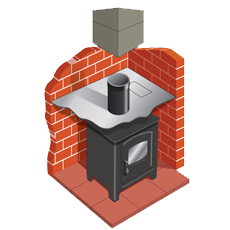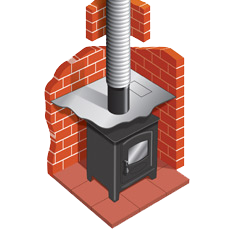Guide to Flues, Lintels, Hearths and Chimneys
Lintels
There are two types of lintels: constructional lintels and throat forming lintels
Constructional lintels
Made of concrete or steel, constructional lintels are used to span the top of the opening of a fireplace and bear the weight of the building materials above it.
Throat forming lintels
Generally a chamfered block which is designed to provide a flat surface parallel with the upper firebrick in order to form an angled passage (or throat) for the fire exhaust fumes to flow through.
When installing an inset stove model with a flue gather you will need to take into consideration the depth of the lintel. Depending on the depth you may need to fit a flue gather to your stove. These come in two sizes:- a short reach (50mm) and a long reach (96mm) flue gather. These will allow you to connect your stove exhaust outlet to a flue pipe. Note: a further adaptor is required to be able to fit a 150mm liner as the inset stoves that required a gather are not DEFRA models
Hearths
The hearth is a slab of non-combustible material that extends underneath and around the stove to protect the floor, carpet etc. from the heat and any burning material that may fall from the stove.
The edge of the hearth must be at a different level from the surrounding floor to define a safe perimeter, a 50mm high Fender may be used on an existing floor for example.
For a stove installed into a recess, the hearth must extend 150mm to the sides of the stove and 225mm in front for a stove that cannot be operated with the doors open such as all of our range, and 300mm for a stove that can be operated with the doors open.
Many stove suppliers only quote the ‘300mm in front’ dimension to ensure they are covered in the event of a problem.
For a freestanding stove not installed into a recess, the hearth size must be at least 840mm x 840mm irrespective of the stove dimensions and a minimum of 150mm to the rear and sides or to a suitably heat resistant walling.
12mm minimum hearth thickness
A freestanding stove, independently certified by a competent body, that has an under stove temperature that cannot cause the hearth temperature to exceed 100°C may stand on an 840mm x 840mm minimum non-combustible material hearth of a minimum of 12mm thick. The stove must also have a clear surrounding hearth area of 150mm to the rear and sides of the appliance.
The regulations covering constructional hearths are quite complex and are fully covered in Approved Document J of the Building Regulations.
Chimneys
An existing chimney should be inspected by a member of any competent persons scheme to ascertain if it is suitable for your new stove installation. A sound chimney does not automatically need lining and it isn’t a specific requirement of ours for a chimney to be lined necessarily.
A very large internal flue is not well suited to wood burning stoves and should be lined suitably in accordance with building regulations and your installer’s advice.
A minimum effective flue height of 4.5m is recommended, Lower overall heights can result in flue draw becoming erratic and susceptible to both under draw and over draw. The flue pressure should be tested and recorded by your installer to testing for flue draw ( 0.12-0.2mbar/12 -20 pa).
Various factors can effect flue pressure including overall height, termination point in relation to nearby buildings/trees, wind pressure/direction, possible insulation of the flue and the route that the chimney takes (bends can hamper the negative pressure).
A 6 inch / 150mm liner is the minimum required diameter for a wood burning or multi fuel stove regardless of proposed fuel type (anthracite etc)
A 5 inch / 127mm liner is only suitable for a solid fuel (only) stove or DEFRA exempt stove installed in a UK smoke control zone.
Liners
Lining generally consists of a stainless steel liner made of two thin layers - an inner and outer layer, sandwiched together. The layers are often made from different grades of stainless steel, i.e. 304, 316 or 904. 304 being the lowest grade and 904 the highest and most corrosion resistant grade.
A minimum of 316/316 stainless steel is recommended- 316/904 is better, 904/904 is best. Avoid 304/304 steel flue liners as whilst these are much cheaper they have only around a 5 year guarantee.
Chimney Sweeping
A chimney should be swept at least once a year. This should preferably be carried out by a suitably qualified chimney sweep or engineer who will provide a certificate on completion covering the visual condition of the flue and compliance with Document J.
A stove used as the main source of heating and burning predominantly wood should be swept twice a year. Your local sweep should be able to offer onsite advice on this.
Connecting a stove to a chimney
There is a distinct difference between a chimney and a flue. A chimney is the permanent structural part of the building, which is usually constructed from bricks. The flue refers to the inner passage which carries the exhaust gases through the chimney. The stove is connected to the chimney or flue with a short length of Vitreous or stainless steel flue pipe. This connecting flue pipe will either terminate above a closure plate or connect directly onto a flue system or liner beyond a register plate.
The connection from the connecting flue pipe to the chimney or flue should be done as soon as is practical, generally above the register plate, providing it is not significantly more than 600mm above the stove outlet, into a suitable sized 150mm minimum flue. If no liner is required then the flue pipe can be suitably terminated above the closure plate. Access in the register or closure plate for cleaning must be provided. Access for sweeping should be provided directly into the connective flue pipe where possible, in accordance with Building Regulations. Your qualified installer should be able to advise further on this.
|
|
|
For rear flue connection, only 150mm of horizontal travel into a sweep-able 'T' is allowed under current Building Regulations.


